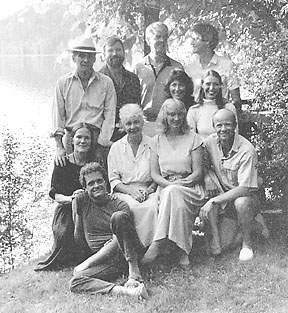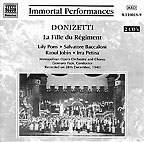History Comes Alive: Naxos Historical and The Canadian Connection by Wah Keung Chan and Philip Anson
/ May 1, 1998
Version française...
 The idea of historical
opera recordings at a budget price was a contradiction in terms
until the recent activities of the Opera Gala (Pelleas Distribution)
and Opera d'Oro (Allegro Distribution) labels. Now a new initiative
between the giant budget CD company Naxos and the British
Columbia-based Immortal Performances Recorded Music Society (IPRMS)
has collectors in a state of high excitement. Naxos Historical, as
the new venture is called, has just released six Metropolitan Opera
radio broadcasts from the 1930s and 1940s, previously available only
on pirate labels at five times the low Naxos price. In many cases
these broadcasts are the only existent recordings from the golden
age of radio of well-known singers in certain roles.
(Photo: The volunteer staff of Immortal
Performances) The idea of historical
opera recordings at a budget price was a contradiction in terms
until the recent activities of the Opera Gala (Pelleas Distribution)
and Opera d'Oro (Allegro Distribution) labels. Now a new initiative
between the giant budget CD company Naxos and the British
Columbia-based Immortal Performances Recorded Music Society (IPRMS)
has collectors in a state of high excitement. Naxos Historical, as
the new venture is called, has just released six Metropolitan Opera
radio broadcasts from the 1930s and 1940s, previously available only
on pirate labels at five times the low Naxos price. In many cases
these broadcasts are the only existent recordings from the golden
age of radio of well-known singers in certain roles.
(Photo: The volunteer staff of Immortal
Performances)
The Canadian behind this exciting initiative is 65-year-old
archivist and sound engineer Richard Caniell. Caniell has always
been a keen collector of old classical music recordings, but back in
the 1970s he became fed up with the shady business practices and
shoddy quality of the products he received from dubbing services and
mail-order houses. In a recent interview from his British Columbia
home, Caniell recalled the problems collectors faced back then.
"Many of the commercially available recordings were poor 5th, 10th
or 15th generation copies. Some recordings offered in the 1960s were
actually intentionally degraded by the engineer who supplied the
source. I know this because I worked as a sound technician at RCA
Victor from 1949–50, and I heard the quality of original tapes."
The last straw for Caniell came in 1979 when he ordered a
Toscanini broadcast from an American dubbing service. His cheque was
cashed, but he never got the recording. Figuring he could provide a
better service himself, he decided to explore the supply side of the
business.
In 1980 Caniell formed IPRMS, a non-profit educational society
based in idyllic New Denver, British Columbia (pop. 600). New Denver
is nestled in the pristine Valhalla mountain range, the background
for Caniell's other activity, the Valhalla Wilderness Society, an
environmental preservation group against over-logging in British
Columbia. Caniell spends his days lobbying the government on
environmental issues and his evenings restoring old operas. "If
people find our office's window display of environmental concerns
and opera singer photos an odd combination, I tell them we are
dedicated to preserving both our environmental and musical
heritage."
Caniell's goal at IPRMS is not to produce slightly better copies
of pirate recordings but to reproduce the master tapes or shellacs
from the original broadcast sources. Of course, it was difficult to
get copies from the Museum of Broadcasting in New York and the
Library of Congress in Washington, D.C., where most of the original
transcripts are housed. Caniell's ten years as a criminal
investigator in Los Angeles was probably good preparation for
tracking down rare broadcast material. He spent 1981–82 licensing
the rights from NBC, obtaining funding from the Canada Council, and
getting endorsement from The National Library of Canada.
"In 1983, I obtained written permission from the Vice-President
of NBC in New York, directing all holders of the transcriptions to
make copies available to us. After that, I also contacted
individuals who had major collections of Met broadcasts." The IPRMS
collected about 2000 historic opera broadcasts from around the
world, including 750 first-generation recordings of Metropolitan
Opera broadcasts. It also owns an extensive collection of Toscanini
broadcasts bequeathed to Caniell by the maestro's favourite RCA
Victor sound engineer, the late Richard Gardner.
With permissions granted and recordings in hand, Caniell started
the labour-intensive job of sound restoration. He recruited thirteen
volunteers in the little town of New Denver by handing out samples of
his work. He also built up a mailing list of 200 members from 13
countries around the world, including many prominent music writers
and critics. Caniell supplied over 600 recordings for Paul Jackson's
second book on Metropolitan Opera Broadcasts, Sign-Off at the Old
Met (Amadeus Press). (Photo: Richard
Caniell, 1984) New Denver by handing out samples of
his work. He also built up a mailing list of 200 members from 13
countries around the world, including many prominent music writers
and critics. Caniell supplied over 600 recordings for Paul Jackson's
second book on Metropolitan Opera Broadcasts, Sign-Off at the Old
Met (Amadeus Press). (Photo: Richard
Caniell, 1984)
In 1995 the IPRM Society almost ceased operations because a
European pirate label was copying its product. According to Caniell,
the president of Eklipse records, Robert Horneman, posed as a
student to obtain over 125 of the IPRMS's best reconstructions, in
flagrant violation of his signed membership agreement (three months
after IPRMS issued a 1936 Met Götterdämmerung to its members,
the same recording was commercially released by Eklipse/Walhall).
Caniell rejected the expensive idea of suing the UK-based company,
and he told at least one person — Texan critic and Callas expert
John Ardoin — that he was going to abandon his work. Two weeks later
he got a fax from Jonathan Wearn of Naxos proposing that Naxos
should issue IPRMS recordings. Caniell had already been approached
by VAI but chose the Naxos offer because it would make IPRMS
recordings cheaply available to a wider public. The first 21
recordings were selected from the IPRMS vault by Caniell, John
Ardoin, and the editor of Hamburg's Orpheus magazine on the
basis of the rarity of the artists and repertoire. Ardoin chose the
1943 Leinsdorf Tristan und Isolde because there was no other
Helen Traubel Isolde on the market. It was recently named Best
Historical Issue by Opera International magazine.
Since signing the deal with Naxos, Caniell has been spending his
nights and weekends restoring tapes for transfer to CD. He admits
that his remastering techniques are not state of the art, but he
hopes the success of the Naxos series will allow him to update the
IPRMS equipment and to learn digital restoration technology.
Restorations can take from three hours to weeks or months (he spent
over two years on Act III of a 1948 Götterdämmerung ).
Voltage variations in the original recording equipment often produce
pitch variations, which must be corrected section by section.
Caniell avoids noise-reduction technology that can reduce the bloom
of the voice (frequencies from 5000-10000 hertz), and he
occasionally boosts the bloom to recreate the excitement of the live
performance. When Caniell uses two original sources, he uses
separate machines to mix to a third machine, all in the analog
domain. Then the recordings are treated in England with the Cedar
System to remove loud successive pops and clicks.
Caniell is generally satisfied with the Naxos issues so far.
"There are still some teething problems: a couple of recordings have
too much or too little bass, but that will be corrected for the next
pressing," he assured us. Future liner notes will also include
photos, a plot synopsis, and biographies of the singers.
Caniell is currently working on restoring a 1944 I Pagliacci
with Raoul Jobin, Licia Albanese and Leonard Warren, which he
tracked down in the National Library of Canada's Jobin collection.
It is of interest to collectors as Albanese's only recorded Nedda,
but Caniell was also pleasantly surprised by Jobin's Canio.
Naxos plans to
release approximately twenty operas and twenty Toscanini broadcasts
per year (all over 50 years old, for copyright reasons). Caniell
also hopes to publish his book on the Toscanini broadcasts. The next
batch of Naxos Historical recordings will be released in Canada this
summer.
- Donizetti: La Fille du régiment
- Lily Pons, Raoul Jobin, Salvatore Baccaloni,
Irra Petina
- Metropolitan Opera, Genno Papi, conductor,
1940
- Naxos 8.110018-9 2CDs
 This recent release of a historic matinée at
the Met in 1940 could not have come at a better time. Not only does
1998 mark the 150th anniversary of Donizetti's death, but this
recording brings back the excellence of the two principal singers:
the soprano Lily Pons and the tenor from Québec, Raoul Jobin. Pons
gives us a marvelous technique -- just listen to "Salut à la
France!" -- but also a smoothness of tone, a sweetness of timbre, an
elegance and vocal charm that are difficult to find today. Her Marie
is both moving and sparkling. You need only listen to "Il faut
partir"... Jobin (and Pons for that matter) exhibits complete
mastery of the comic-opera style, but that's not all. His Tonio is
overwhelming for its ease, brightness and beauty of voice and for
its dramatic tone. One must listen to Jobin sing the cavatina, "Ah
mes amis!" to realize how mediocre modern tenors sometimes are. How
unfortunate, then, that this production has the traditional cuts
such as the cabaletta of that cavatina and Tonio's sublime aria,
"Pour me rapprocher de Marie". On the other hand, Salvatore
Baccaloni's Sulpice does not have the same idiomatic dimension, and
his incarnation is decidedly exaggerated. As for the Italian
conductor, Gennaro Papi, he directs the orchestra with energy and
flexibility. Good sound quality. Great! Richard
Turp This recent release of a historic matinée at
the Met in 1940 could not have come at a better time. Not only does
1998 mark the 150th anniversary of Donizetti's death, but this
recording brings back the excellence of the two principal singers:
the soprano Lily Pons and the tenor from Québec, Raoul Jobin. Pons
gives us a marvelous technique -- just listen to "Salut à la
France!" -- but also a smoothness of tone, a sweetness of timbre, an
elegance and vocal charm that are difficult to find today. Her Marie
is both moving and sparkling. You need only listen to "Il faut
partir"... Jobin (and Pons for that matter) exhibits complete
mastery of the comic-opera style, but that's not all. His Tonio is
overwhelming for its ease, brightness and beauty of voice and for
its dramatic tone. One must listen to Jobin sing the cavatina, "Ah
mes amis!" to realize how mediocre modern tenors sometimes are. How
unfortunate, then, that this production has the traditional cuts
such as the cabaletta of that cavatina and Tonio's sublime aria,
"Pour me rapprocher de Marie". On the other hand, Salvatore
Baccaloni's Sulpice does not have the same idiomatic dimension, and
his incarnation is decidedly exaggerated. As for the Italian
conductor, Gennaro Papi, he directs the orchestra with energy and
flexibility. Good sound quality. Great! Richard
Turp
Version française... |
|


